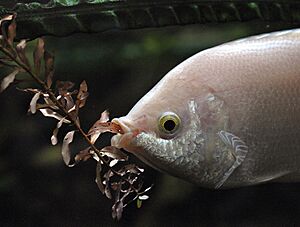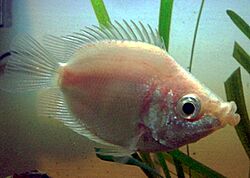Kissing gourami facts for kids
Quick facts for kids Kissing gourami |
|
|---|---|
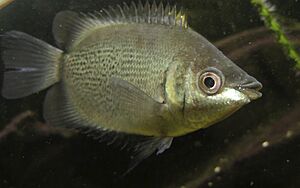 |
|
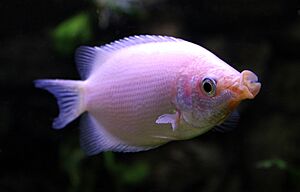 |
|
| Natural form above, Leucistic form below |
|
| Conservation status | |
| Scientific classification | |
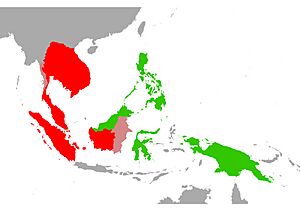 |
|
| Red: extant, Light red: possibly extant, Green: introduced |
Kissing gouramis, also known as kissing fish or kissers (Helostoma temminckii), are a type of medium-sized tropical fish. They live in freshwater and are known for their unique mouth. These fish belong to a special family called Helostomatidae. Their name comes from Greek words that describe their mouth.
These fish originally come from Mainland Southeast Asia, like Thailand and Indonesia. But people have also moved them to other parts of the world. People sometimes eat kissing gouramis, and they are even raised on farms for food. They can be cooked in many ways, like steaming or baking. The kissing gourami is also a very popular fish to keep in aquariums.
Contents
What Do Kissing Gouramis Look Like?
Like other gouramis, these fish have a deep body that is quite flat from side to side. Their top fin (dorsal fin) and bottom fin (anal fin) are long and look like mirrors of each other. The back parts of these fins are a bit longer, giving them a flowing edge. Their front fins (pelvic fins) are also a little long. The side fins (pectoral fins) are large, round, and set low on their body. Their tail fin can be rounded or slightly curved inward.
The most special part of the kissing gourami is its mouth. Unlike some other gouramis, its mouth faces forward, not upward. It can also stick out very far, almost like a tube. The lips have hard, tooth-like parts. However, they don't have teeth on other parts of their mouth or throat. Kissing gouramis can grow up to about 30 centimeters (12 inches) long. It's very hard to tell the difference between male and female fish just by looking at them.
Colors of Kissing Gouramis
You can find kissing gouramis in two main colors:
- Greenish-silvery: These fish have stripes of spots along their body and dark brown fins that you can't see through. This is their natural color in the wild.
- Pink: These fish have a rose or orangy-pink body with shiny, silvery scales. Their fins are clear and pinkish. This pink color is not natural. It's a special type of fish created by people through selective breeding in captivity.
Their Special Jaw and Mouth
The kissing gourami's mouth is truly unique! It has an extra joint in its jaw, called an intramandibular joint. This joint is also found in some other fish that eat food stuck to surfaces. This extra joint lets the kissing gourami open its mouth wider. This helps them reach food, like algae, that is attached to rocks or plants. The kissing gourami is the only fish known to use this joint in this special way for feeding.
This extra joint divides the jaw into two parts that can move separately. This gives the fish more ways to grab food. Scientists are still studying exactly how this joint works. But it's clear that it's a great adaptation that helps H. temminckii find and eat its food.
Where Kissing Gouramis Live and What They Do
Kissing gouramis naturally live in shallow, slow-moving waters that have lots of plants. They are omnivores, meaning they eat both plants and animals. They mostly graze on algae and water plants found at the bottom. They also eat insects from the water's surface. They can even filter tiny bits of food, like plankton, from the water using special parts in their gills.
These fish use their special lips to scrape algae off stones and other surfaces. This scraping action looks a lot like kissing to us! Male kissing gouramis also use this "kissing" action to challenge other males and show who is stronger.
How Kissing Gouramis Interact
Kissing gouramis are famous for their "kissing" behavior. Two fish will bring their mouths together and press them for a few seconds. This is why they are called "kissing gouramis." This behavior is thought to be a way for them to show aggression towards each other, almost like a "mouth fight." However, it's not always a truly aggressive fight. It's often seen as a ritualized way for them to settle disagreements without serious harm.
Their Role in the Ecosystem
Helostoma temminckii can sometimes have tiny algae living on their skin, like parasites. These algae look like colored spots. Some scientists think these algae get nutrients from the fish. Fish with these algae parasites are usually not as healthy as those without them.
Kissing gouramis can also communicate with each other. They have a complex inner ear that helps them hear better by using air bubbles. They can also make sounds by moving their teeth, which helps them talk to other fish of their kind.
Reproduction and Life Cycle
Kissing gouramis lay eggs, and the male and female fish are separate. Fertilization happens outside the body. In places like Thailand, they lay their eggs from May to October, which is when the rainy season begins.
Kissing gouramis scatter their eggs in open water, usually under floating plants. The adult fish do not guard their eggs or care for their young. The eggs are round, smooth, and float on the water. They hatch quickly, usually after just one day. The baby fish (fry) can swim freely two days after hatching.
Adult fish travel through rivers to shallow lagoons or flooded forests to lay their eggs. A female fish can release about 1,000 eggs at a time. The eggs are small and have a drop of oil inside to help them float. Fertilized eggs float to the surface and often stick to floating plants, where they develop into larvae. Kissing gouramis usually become old enough to reproduce when they are three to five years old.
What Kissing Gouramis Eat
The kissing gourami is an omnivore that filters tiny food particles from the water. They eat a wide variety of things, including insects, algae, larvae of other species, and other tiny living things found underwater. Their special mouth, teeth, gills, and especially that unique intramandibular joint, make them very good at finding food. They can get nutrients from places where other fish cannot, like surfaces covered in algae.
Kissing Gouramis in Aquariums
Kissing gouramis are very popular with people who keep aquariums. This is because of their funny "kissing" behavior with other fish, plants, and objects. Male and female kissers will often "spar" by meeting mouths and pushing each other around the tank. Many of these fish are sent to countries like Japan, Europe, and North America just for this reason.
Kissing gouramis need a large tank to be happy and healthy. They grow quickly, and young fish will soon become too big for small aquariums. These fish can be territorial. Some are fine with other fish of similar size, but others might bully or chase their tank mates. This can cause a lot of stress for the other fish. While the "kissing" itself is usually not harmful, constant bullying can stress other fish so much that they get sick or even die. They might also harm other fish by sucking the protective slime (mucus) off their skin, which can lead to infections.
These fish can be helpful in an aquarium because they eat algae. To help them, you should use large gravel and stones at the bottom of the tank. You can also leave the back glass of the aquarium uncleaned during regular tank maintenance, as the gouramis will eat the algae that grows there. Most live plants won't survive with these fish because they will graze on them. So, it's better to use plants they won't eat, like Java fern, Java moss, or plastic plants.
Kissing gouramis are omnivores, so they need both plant and animal matter in their diet. They will eat vegetables like cooked lettuce and various live foods. The water in their tank should be between 22 and 28 degrees Celsius (72 to 82 degrees Fahrenheit). For breeding, softer water is usually preferred. Since they don't build nests, you can place lettuce leaves on the water surface. These leaves will eventually grow bacteria and tiny organisms that the fish will eat. Kissing gouramis in aquariums can grow to be between 30 and 40 centimeters (12 to 16 inches) long. They can also live a very long time, sometimes over 25 years!
Aquarium breeders have also created a "dwarf" or "balloon pink" variety. This is a mutated version of the pink gourami that has a smaller, rounder body.
How Long Do Kissing Gouramis Live?
In both captivity and the wild, the average lifespan for a kissing gourami is 5 to 7 years. However, it is known that some kissing gouramis can live much longer than that.
See also
- List of fish families



